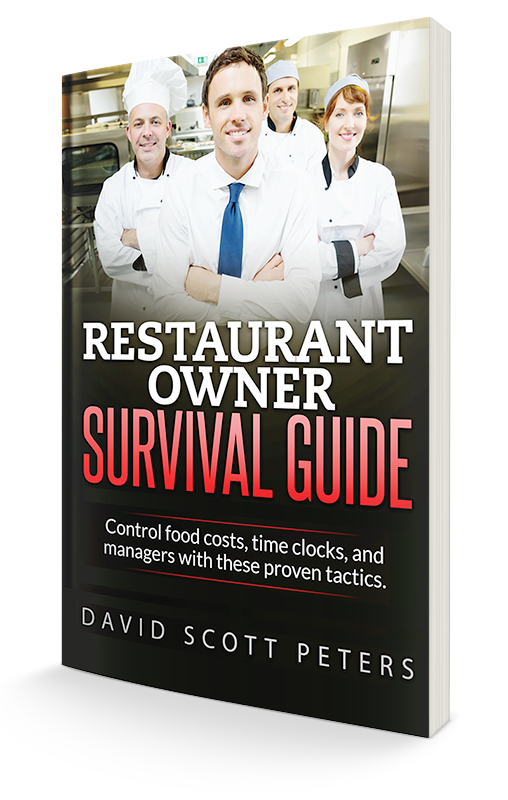If You Don’t Believe, It Can’t Be Done
In many of my speeches, seminars, workshops and calls with potential Members, I talk about how industry standards don’t apply to the restaurants we work with. For a lot of restaurant owners, this is a hard concept to accept. They choose not to believe it instead of opening their minds to the possibilities.
What are those industry standards? Well, they start and end with prime cost, the one number you must know in your business if you hope to have any chance of making any real money in the restaurant business.
Prime cost is your total cost of goods sold plus your total labor cost, which include taxes, benefits and insurance. Owner salaries are the only tricky part. If you as an owner actually manage a shift, you are part of prime cost. If you only work two shifts as a manager on the floor, two-fifths of your salary belongs in prime cost. And to clarify, if you have a full-time or part-time bookkeeper or marketing person, they are not included; they are pure overhead.
OK, now that we have reviewed what goes into that number, where should your numbers be?
When I first started my company in 2003 I was pushing to get all of my members down to 60 percent. Then the economy took a dive, the recession was upon us and restaurant costs were skyrocketing. This caused us as experts to look long and hard at the restaurant industry as a whole. We determined that a NEW standard needed to be created. We decided we were going to move our members who do $850,000 a year or more in sales down to a 55 percent target!
How do you get to 55 percent or lower? It requires three things:
- Adopt the philosophy that industry standards don’t apply.
- Never let up.
- Know where to start.
1. A new philosophy
I can’t tell you how many accountants or multi-unit operators we have come across who quoted the old 65 percent number and then proceeded to tell us it was IMPOSSIBLE to hit a 55 percent prime cost.
The thing that really blows my mind is that the higher your sales volumes, the lower we can move that number. Fifty-five percent has become more than achievable.
Let me share with you a few examples.
- How about a steakhouse? No way a steakhouse could run a prime cost that low, right? Wrong! One of our Elite Members runs a steakhouse with Certified Angus Beef that is both wet and dry aged; I’m talking about top quality meats. They have $4 million in annual sales. They are running a 50 percent prime cost.
- How about another Elite Member who has two Tex-Mex restaurants? One restaurant does about $1.4 million a year and it runs at a 54 percent prime cost. His $4 million restaurant runs at a consistent 42 percent prime cost and hit a record low of 39.96 percent at one point!
- How about a Winner Circle Member who owns a seafood restaurant running at 49 percent?
And the list goes on, from sandwich shops and burger joints to fine dining… industry standards don’t apply.
You know how these restaurants are achieving these kind of incredible results? They believe that it’s possible! They don’t make a bunch of excuses, and they certainly don’t say, “but you don’t understand, my restaurant is different.” Instead they start thinking in new ways; they adopt a new philosophy. They understand it’s a marathon, not a sprint.
2. Never let up
The second part of being successful in this process is never resting on your laurels. The moment you take things for granted thinking everyone on your team knows what they are doing, and you don’t have to watch over them, your prime cost will skyrocket back up: each and every time. Our owners and managers know they must continue to measure, train and coach, or their hard earned results can go away in a New-York minute.
3. Know where to start
The third part of achieving these results is to understand how to get there. And that’s the $20 million question, “Where do I start?”
The answer is different for everyone. It depends on where you are bleeding the most, what you are or are not willing to change, and your core values.
Since prime cost is the combination of cost of goods sold and labor costs, it means you have the flexibility to change one or the other or both to achieve success. There are many combinations that get you to 55 percent or lower.
Sometimes a restaurant owner will not change their labor cost targets down because they refuse to cut the hours or income of their employees. They just can’t bring themselves to do so because they are very loyal to them and want to make sure everyone is taken care of. In these kinds of situations, the answer is easy: aggressively attack cost of goods sold.
Even in this situation, an owner will start with the excuses and say, “But I don’t want to purchase cheaper ingredients to make that happen and that’s the only way you could possibly reduce my prime cost.”
This is where your core values come in. We are not going to push you to change your business in any way that conflicts with your core values. When we attack your cost of goods sold we do it through menu engineering to achieve our desired results AND use ingredients that are in season, the best quality and most flavorful and cheaper. We can give your customers an even better product, while reducing your costs.
As a side note, let me point out that it’s important to measure prime cost off of gross sales and not net! Gross sales are sales at the register before discounts are subtracted and do not include sales tax collected. This goes against industry standards as well. Because if you measure off of net sales, after the discounts have been taken out, you’re going to make some really bad decisions in your business and you’re going to think your management team is doing a terrible job.
Let me explain. Let’s say you are going to hold an event in your restaurant for your favorite charity. It’s a $10,000 event. You have decided you are going to COMP 50 percent of the ring. That means you are only going to collect $5,000 in revenue from the event. My question to you is are you going to purchase food for a $10,000 event or a $5,000 event? Are you going to staff for a $10,000 event or a $5,000 event? The answer is a $10,000 event. So to accurately measure your prime cost, you must measure against gross sales.
The lesson is, “Don’t tell me how it can’t be done; instead tell me how it can be done.” When you stop thinking in negative terms, you start getting results you once thought were impossible.
Remember, if you don’t believe, it can’t be done. Think in new terms of success. Do what needs to be done even if it’s difficult. Last but not least, remember, “that which we measure improves!”




